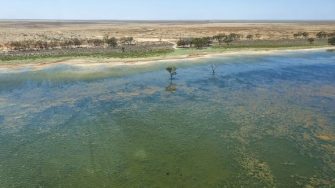
Date: Tuesday, November 12, 2019
Project: Eastern Australian Waterbird Survey
Observers: John Porter UNSW/DPIE & Andrea White DEWLP
Trainee: Heath Dunstan
Pilot: Tim Dugan
Strong hot winds dominated the weather today as we set out from Sydney into a stiff headwind, bound for central NSW and Victoria. Lake Cowal was dry as we overfly it en route to Lake Cargellico. The wind is strong enough to whip up white caps on the lake and the birds are reluctant to fly – who can blame them? We find small numbers of grey teal, black duck, darters and pelicans.
Lake Cowal is dry
Surveying over Lake Cargellico
The Booligal wetlands are a series of beautiful lignum swamps, lakes, waterways and floodout areas along Merrowie, Merrimajeel and Booligal Creeks – today’s dry conditions mean there are only a few small patches of water with low numbers of waterbirds; mainly black duck, grey teal and black tailed native hens. Some of the wetlands have become slightly brackish, causing the water to become clear with macrophytes carpeting their bottoms. When filled, these wetlands provide vital breeding and feeding habitat for huge colonies of straw-necked ibis, white ibis and yellow-billed and royal spoonbills.
Dry conditions on Merrowie Creek
Our next stop is The Great Cumbung Swamp, a vast reed swamp, one of the largest of its kind remaining in the Murray-Darling where the Lachlan River meets the lower Murrumbidgee. It’s a haven for waterbird feeding and breeding. Once again the dry conditions have taken their toll and the wetland is only 20% full with low numbers of waterbirds and little or no breeding in progress. The environmental flows are an important way of ensuring that these system survive these intense droughts. Thankfully these reedbeds have not had the same burns in the Macquarie Marshes and Gwydir wetlands. The Nature Conservancy (TNC) — has recently purchased two of the properties near Oxley that form part of the Cumbung Swamp in a joint venture with Tiverton Agriculture to help manage and conserve this unique wetland.
Surveying over the Great Cumbung Swamp
Great Cumbung Swamp
Today’s gusty winds have worsened and visibility is poor with smoke haze and clouds of dust which all combine to make counting very unpleasant. We finish counting the area in rough conditions and then head to Griffith to refuel. It is clear the area is badly drought affected with only half the average rainfall this year. Our next stop is Kerang Lakes – where we find most of the lakes are almost full. The deeper lakes have relatively few birds but a couple of the shallower more brackish lakes such as Lake Cullen have thousands of grey teal, hardhead, Black Swans, Coot and pink-eared ducks, and hundreds of mountain duck, stilts and avocets – a welcome site after so many days of low counts. Middle Lake has a colony of over 500 straw-necked ibis – one of the largest colonial breeding records for this year.
Saline clear water on Lake Cullen
